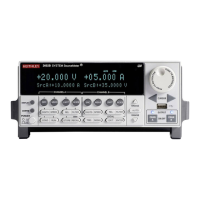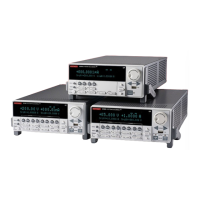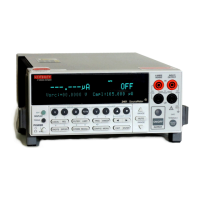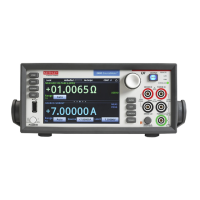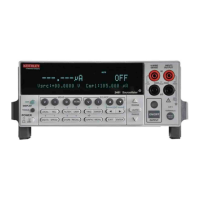Series 2600 System SourceMeters Reference Manual Instrument Control Library 12-71
Return to Section 12 topics 2600S-901-01 Rev. A / May 2006
Remarks
• This function generates and activates new calibration constants for the given range.
The positive and negative polarities of the instrument must be calibrated separately.
Use a positive value for
range to calibrate the positive polarity and a negative value
for
range to calibrate the negative polarity.
• Typically the two calibration points used will be near zero for calibration point 1 and
90% of full scale for calibration point 2.
• All four measurements (cp1measured, cp1reference, cp2measured, and
cp2reference) must be made with the active calibration set. Corruption of the
calibration constants may result if this is not heeded.
• The new calibration constants will be activated immediately but they will not be
written to non-volatile storage. Use
smuX.cal.save to commit the new constants to
nonvolatile storage. The active calibration constants will stay in effect until the
instrument is power cycled or a calibration set is loaded from non-volatile storage
with the
smuX.cal.restore function.
• This function will be disabled until a successful call to smuX.cal.unlock is made.
Details See Section 16 (calibration).
Also see smuX.cal.restore, smuX.cal.save, smuX.makebuffer, smuX.source.calibrateY
smuX.measure.count
X = SMU channel (a or b)
Attribute Number of measurements performed when a measurement is requested.
Usage
count = smuX.measure.count -- Reads measure count.
smuX.measure.count = count -- Writes measure count.
count Number of measurements.
Remarks
• This attribute controls the number of measurements taken any time a measurement
is requested. When using a reading buffer with a measure command, the
count
also controls the number of readings to be stored.
•The reset function sets the measure count to 1.
Details See “Triggering” in Section 4.
Also see smuX.measure.overlappedY, smuX.measure.Y
Example
Sets measure count for SMU A:
smua.measure.count = 10

